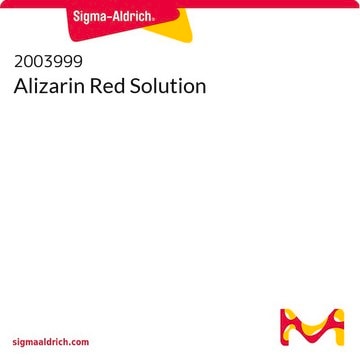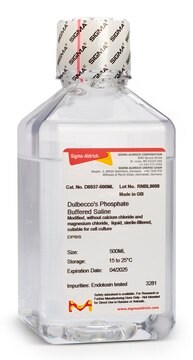01-2180
Alizarin Red S
SAJ special grade
Sinónimos:
3,4-Dihydroxy-9,10-dioxo-2-anthracenesulfonic acid sodium salt, Alizarin Carmine, Alizarin Red, water soluble, Alizarin sodium monosulfonate, Alizarin sulfonate sodium, Alizarinsulfonic acid sodium salt, Sodium alizarinsulfonate
About This Item
Productos recomendados
grado
SAJ special grade
disponibilidad
available only in Japan
cadena SMILES
[Na+].Oc1c(O)c(cc2C(=O)c3ccccc3C(=O)c12)S([O-])(=O)=O
InChI
1S/C14H8O7S.Na/c15-11-6-3-1-2-4-7(6)12(16)10-8(11)5-9(22(19,20)21)13(17)14(10)18;/h1-5,17-18H,(H,19,20,21);/q;+1/p-1
Clave InChI
HFVAFDPGUJEFBQ-UHFFFAOYSA-M
¿Está buscando productos similares? Visita Guía de comparación de productos
Código de clase de almacenamiento
11 - Combustible Solids
Clase de riesgo para el agua (WGK)
WGK 3
Punto de inflamabilidad (°F)
Not applicable
Punto de inflamabilidad (°C)
Not applicable
Equipo de protección personal
dust mask type N95 (US), Eyeshields, Gloves
Elija entre una de las versiones más recientes:
¿Ya tiene este producto?
Encuentre la documentación para los productos que ha comprado recientemente en la Biblioteca de documentos.
Nuestro equipo de científicos tiene experiencia en todas las áreas de investigación: Ciencias de la vida, Ciencia de los materiales, Síntesis química, Cromatografía, Analítica y muchas otras.
Póngase en contacto con el Servicio técnico








